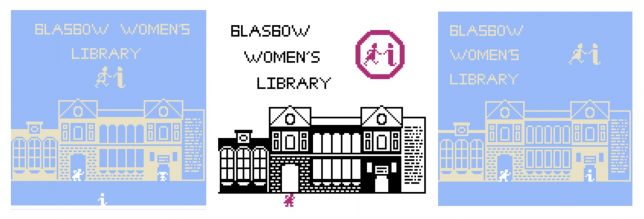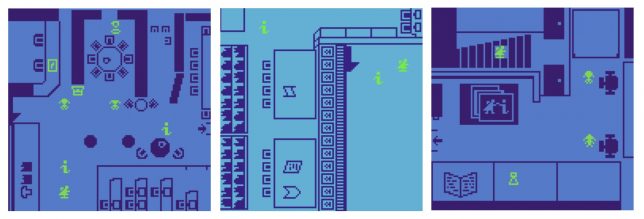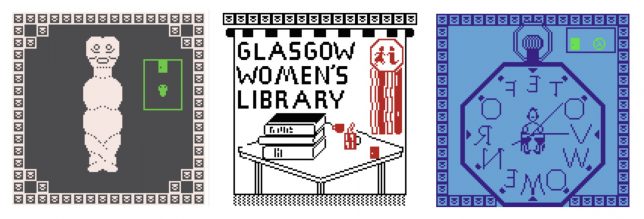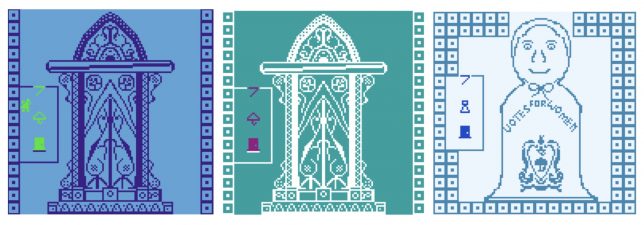Student Paige Plannette shares more insights into her University of Glasgow Museum Studies placement with GWL during the coronavirus lockdown
Hello again!
The lockdown due to Covid-19 meant that University of Glasgow students like me had to look for new ways to complete our work study placements. While sadly I could no longer come in to work physically with the library collections, a new opportunity presented itself: instead of digitising physical museum objects, I would build a two-dimensional game that would allow players to explore the museum and its objects digitally.

Using the platform of Bitsy (a game-building format), I could create a task-based exploration game in a pixelated format. There were so many things to consider, such as what sort of tasks a player could complete, how to present the rooms, what sort of colour palette to use, what the actual goal of the game is, whether the game should be educational or fun or both, and how to represent GWL and its values within the game. I began brainstorming! Focusing on the purpose and values of GWL, I decided to focus on creating a digital version of the library where players would have the opportunity to see what they could do there.
Next, I visualized how to digitally represent the library’s space. To do this, I sorted through photos I had taken while there, examined ground plans, explored the GWL website and used as inspiration the Lego sets of the GWL built by GWL volunteer, Aileen. The main rooms of the library would have a mainly aerial perspective to provide ease of movement, whereas special objects and the front of the building would be from a face-front perspective.

A main feature of the game is the pixelation of specific museum objects. In order to highlight what the library has to offer, intriguing and beloved objects have been pixelated and the player will have the opportunity to interact with them. The game focuses mainly on looking at the objects in each room and doing small tasks. The visitor or player can encounter three different types of interaction within the game: information icons, characters, and objects. The information icon provides info on how to operate within the game, the figures represent people who work in the library who will either introduce a task or provide info about their job, and museum or library objects which will give a short description about themselves.
The text or dialogue was one of the most challenging parts of the game. I wanted the interactions to provide information without being overly long or boring. One key game character is the avatar. Modelled after the woman in the GWL logo, I wanted to portray this small character as being full of zest and life and upholding GWL’s values, though in a very small pixelated package. To me, she looks as though she is ready to meet the world!
One of the next areas I worked on is the overall colour palette, which I may have spent more time on than I probably should have. Each screen of the game is limited to three different colours. I went from trying to present the library or objects in three colours that were as close to their actual places or objects to trying to constrain all of them into the main colours of GWL’s logo to what I (hope) is more visually appealing within the game. Feedback from the team at GWL was particularly helpful in this regard; for example, admin worker Helen directed me to colour accessibility websites and suggested research into how contrasting colours present on screen and pair well for easy seeing.

While I enjoyed all the aspects of designing the game, my favourite part was recreating the objects. Though a variety of objects are showcased, my two favorite ones are the Suffragette Umbrella Stand and the Votes for Women Bell.
Believed to be painted by Suffragettes who had been imprisoned at Glasgow’s Duke Street Prison, the umbrella stand was one of the first things I saw upon entering the library. I adored it and the story of how it got its colour instantly. It was the very first object that I designed in the game. Trying to translate this intricate, beautiful, meaningful object into the 2-dimensional was challenging. I began with marking out the basic outline and then slowly built the details, finishing with the colour palette. Originally, I tried to get as close to the actual colours of the stand but eventually realized it just did not translate as well. The white was not coming up clearly enough on the blue background.

The bell was the second object I designed, and it presented its own challenges. Made out of ceramic, the bell has two different sides, each of a woman’s head and with different Women’s Suffrage slogans: “Votes for Women” and “This one shall have the vote.” Visualising curved surfaces was not the easiest thing but I wanted it to look as close as possible to the actual object as I could get. I did not quite succeed in achieving the slight tilt of the head but being able to achieve something that contained some of the intricacies of the object’s design was quite enjoyable!
More than a simple digital representation of GWL, the game aims to explain and narrate the role of the library in the community. Though creating a digital game was not one of my original goals, the creation process helped me understand that GWL is more than just a physical space. I hope that for players, the game will serve as a digital window into what Glasgow’s Women’s Library is and what it holds within its doors. Watch this space…

Comments are closed.